
A lesson of leadership in construction…(with strong wind in its sail).
Amidst the sounds of hammers on steel and the whirr of drills, there was a subtle tension in the air at one of our client’s construction sites. It was not…
Please leave your details below and somebody will get back, today.
You don’t want to be one of the 86 tradesmen and workers who die every single week from asbestos in the UK. That’s not 86 per year, it’s 86 every week.
The reason this figure is so high is of course because asbestos lurks everywhere in buildings put up before 1999. For an overall guide to asbestos, see our detailed guide here;
In this post, I’ll give you a crystal clear picture of where the danger points are in any property. All images are courtesy of the HSE.
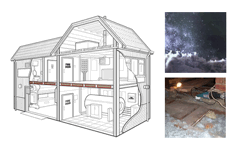 This is by far the most dangerous form of asbestos, because it’s 100% asbestos, and is lose filling in flooring cavities, in walls and lofts. It looks lose and fluffy, and you mustn’t touch it or work on it for any reason unless you are a HSE-licensed contractor.
This is by far the most dangerous form of asbestos, because it’s 100% asbestos, and is lose filling in flooring cavities, in walls and lofts. It looks lose and fluffy, and you mustn’t touch it or work on it for any reason unless you are a HSE-licensed contractor.
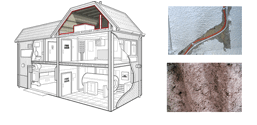 This is also one of the really dangerous asbestos materials, because it’s 85% asbestos and breaks up really easily – never do any work on it unless you are a HSE licensed contractor.
This is also one of the really dangerous asbestos materials, because it’s 85% asbestos and breaks up really easily – never do any work on it unless you are a HSE licensed contractor.
You find it most commonly on Steelwork, concrete soffits and the underside of roofs, and sometimes the sides of buildings. Unless sometimes it’s been covered with cloth fabric and its been painted, it’s grey and has a rough surface.
 Found around heating systems, as calorifiers, pipework and on or in round boilers – this is also an extremely dangerous form of asbestos, because when disturbed it is so easily airborne, to be breathed in. It’s a fibrous material which flakes easily, and is usually painted so there’s no particular colour to give it away. It’s also commonly found as a residue to walls and surfaces following historical asbestos removal works long ago. Don’t touch unless you are a HSE-accredited contactor.
Found around heating systems, as calorifiers, pipework and on or in round boilers – this is also an extremely dangerous form of asbestos, because when disturbed it is so easily airborne, to be breathed in. It’s a fibrous material which flakes easily, and is usually painted so there’s no particular colour to give it away. It’s also commonly found as a residue to walls and surfaces following historical asbestos removal works long ago. Don’t touch unless you are a HSE-accredited contactor.
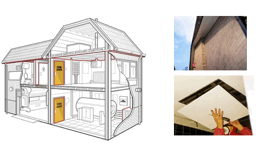 This used to be incredibly common for fireproofing, ceiling tiles, panels under window, partition walls, soffits, blanking panels, floor packers and lift shaft linings. Remember never do any work on it unless you are a HSE licensed contractor
This used to be incredibly common for fireproofing, ceiling tiles, panels under window, partition walls, soffits, blanking panels, floor packers and lift shaft linings. Remember never do any work on it unless you are a HSE licensed contractor
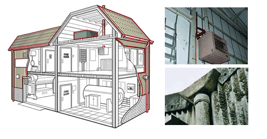 You can tell asbestos cement with analysis and a water absorption test, or by sight for most experienced surveyors. It’s basically ordinary cement mixed with asbestos – up to 30%. It’s less dangerous than other asbestos forms and you don’t need a license to work on it. But be very careful anyway! But you still need to be appropriately trained (one-day non licensed) and usee all the correct PPE and RAMS.
You can tell asbestos cement with analysis and a water absorption test, or by sight for most experienced surveyors. It’s basically ordinary cement mixed with asbestos – up to 30%. It’s less dangerous than other asbestos forms and you don’t need a license to work on it. But be very careful anyway! But you still need to be appropriately trained (one-day non licensed) and usee all the correct PPE and RAMS.
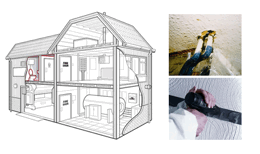 These contain asbestos and were used to protect decorative finishes on ceilings and walls. Among the less harmful forms of asbestos, but still dangerous. Always be careful. But you still need to be appropriately trained and use all the correct PPE and RAMS
These contain asbestos and were used to protect decorative finishes on ceilings and walls. Among the less harmful forms of asbestos, but still dangerous. Always be careful. But you still need to be appropriately trained and use all the correct PPE and RAMS
 You’ll find asbestos hidden away in lots of little places. Like the floor tiles under carpets. Or in fuse boxes, or if you have an old fire blanket, it may be made using asbestos. The asbestos composites used to be used in toilet seats, bath panels and window sills.
You’ll find asbestos hidden away in lots of little places. Like the floor tiles under carpets. Or in fuse boxes, or if you have an old fire blanket, it may be made using asbestos. The asbestos composites used to be used in toilet seats, bath panels and window sills.
They’re hard to identify by looking alone, you can look up the trade name online and see if it’s made with asbestos. It’s not the most dangerous form, but as always, it’s still dangerous, so handle with care! But you still need to be appropriately trained and use all the correct PPE and RAMS
You can find out more about this nasty customer at the HSE website. And Always check with HSE guidelines and an HSE licensed surveyor before working with asbestos.
Remember those 86 a week – it’s too big a risk to take!
There is a legal requirement under the Control of Asbestos regulations to manage the risk of exposure to Asbestos in a property so, you must get an Asbestos Survey completed before you start any refurbishment works in your property.
Got any questions about asbestos?
Ask away, we love to chat!